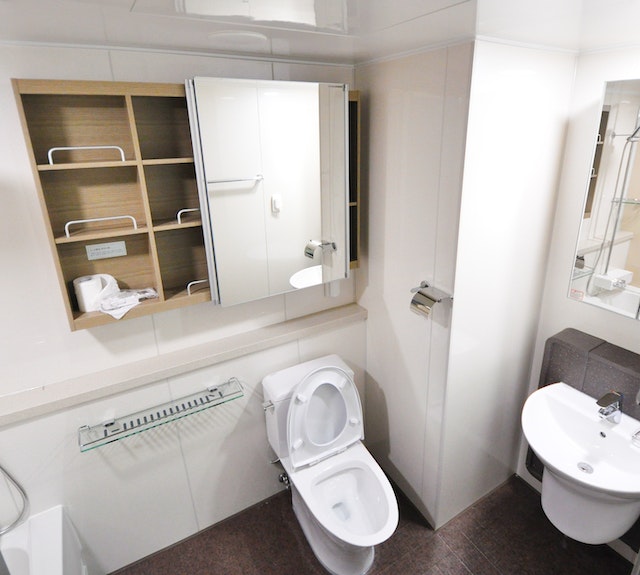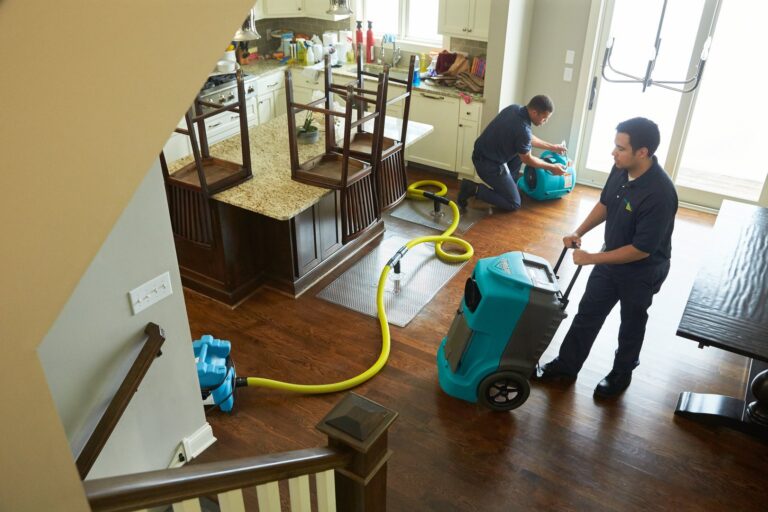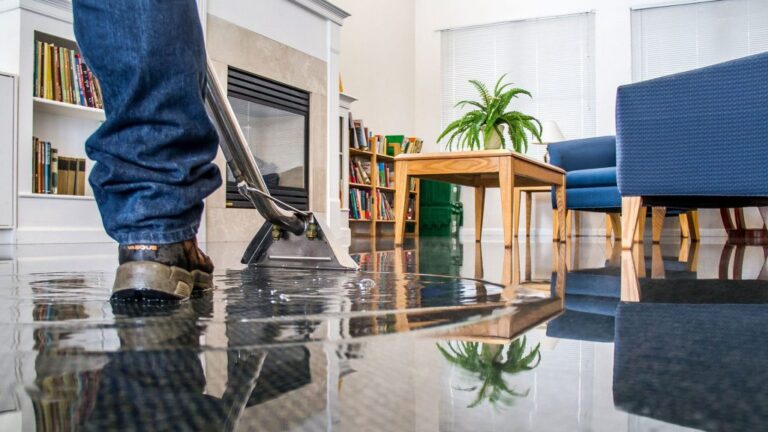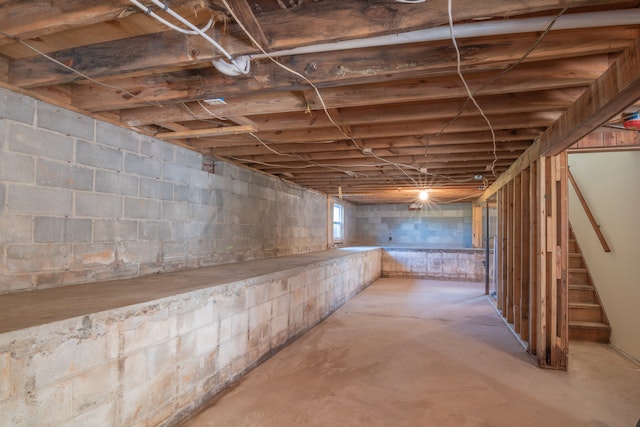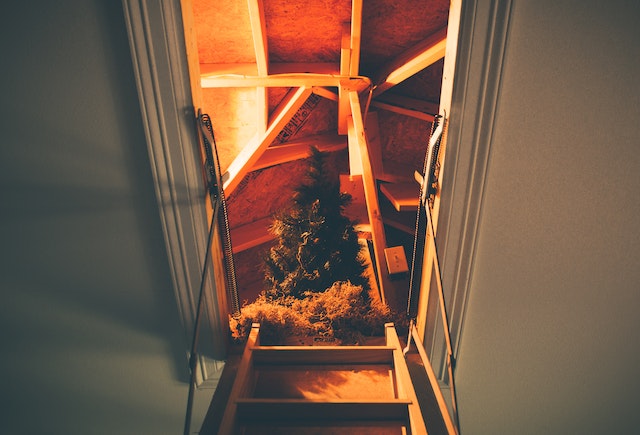Learning how to clean up toilet flood overflow is essential whether you rent or own your property. Toilets commonly overflow for a number of reasons, and prompt repairs and cleanup can protect you and your family from the dangers of standing sewage water.
It can be incredibly stressful when a toilet overflows. Contacting a restoration company right after experiencing a toilet overflow can help you minimize damages and remove all dangerous traces of bacteria in a timely manner.
How To Safely Clean Toilet Overflows
Once a toilet overflows, it’s crucial to stop the clog and safely clean up all flood water. Here are a few steps to take when dealing with a flooded toilet:
Step 1 – Contact a Restoration Company
If a toilet overflowing causes water damage in your bathroom, contacting a restoration company should be one of the first steps.
In addition to helping you collect quotes for hiring a plumber, a professional restoration company can also assist with collecting evidence for an insurance claim and guiding you through the cleanup process.
Step 2 – Stop the Overflow
Turn off the water shut-off valve to stop the water flow. You have a few options available when it comes to turning off the water. If you’re by yourself, you can turn off the water supply line using the shut off valve.
If you have another person nearby, you can turn off the water within the tank. Remove the toilet tank lid and have one person push down on the flapper and hold the rubber valve located in the tank.
This temporarily will stop additional water from entering the tank. Then, the other person shuts off the valve at the supply line.
You can turn off the water valve to prevent more water from flooding your bathroom. If this doesn’t stop the toilet overflow, you can always temporarily turn off the water at the main water supply line.
In the meantime, try not to flush or drain the toilet until repairs are complete.
Step 3 – Unclog the Toilet
Some causes of toilet clogs are DIY friendly. For example, you may be able to use a regular plunger for small clogs. For the best results, apply some petroleum jelly to the plunger to make a tight seal before you flush. However, a plunger may not always be enough to repair a clogged toilet.
If you need something more, try a toilet auger to remove a clog. An auger is an S-shaped trap tool that goes a few inches into the toilet drain and helps break up a clog. Gently pull it through the sewer line to free the clog without causing damage to your toilet.
If you’re still unable to free the toilet clog, you may need to call a professional plumber.
Step 4 – Contact a Plumber (If Necessary)
A professional plumber can help you locate the clog, especially if it’s further down the plumbing line. Using a camera to find and clear the clog, they can also perform a plumbing snake.
A plumber can also make repairs to the septic tank. However, plumbers rarely wash bathroom surfaces after, so you’ll still need a restoration or remediation company to assist with cleaning and sanitizing.
Step 5 – Begin the Cleaning Process
If possible, you can begin cleaning up some of the overflow water. Remember that the water may be a biohazard, so you’ll likely need the appropriate protective gear. This includes waders, boots, and rubber gloves. In many cases, it may be worth waiting for the professional remediation company to arrive.
You can use old towels to soak up water on the bathroom floor. Be sure to wear rubber gloves when touching any items soaked by the water source. Additional cleaning materials to prepare include old towels, bleach, an empty bucket, soap, and paper towels.
Step 6- Remove Standing Water/Damaged Materials
A wet bathroom can be dangerous and expensive if left alone. The first step in the restoration process is to remove all standing water from the bathroom. You’ll need to act quickly when removing water damage to avoid mold growth.
You may need a dry vacuum, depending on how much water overflowed. Large commercial-grade fans can also help promote airflow to help dry out the bathroom. You can also use a large mop to clean up the toilet water, especially if there is an excessive amount.
Don’t forget to clean out the equipment and dispose of the wastewater as soon as possible. You can store it in a bucket while cleaning to stop additional water from affecting your bathroom floor or walls.
Once you’re done cleaning the area with warm water and bleach, flush the contents down the toilet. Don’t forget to rinse out the bucket and wash the mop.
Step 7 – Wash and Dry the Bathroom Floor and Walls
Now it’s time to dry out the bathroom and minimize moisture levels. Any traces of water left behind can cause the wood to rot and become structurally unsafe. Excess water in the bathroom can also lead to mold or fungus growth. Bacteria growth is especially common when dealing with a toilet overflow.
One of the problems with cleaning up after a bathroom flood is that water frequently gets trapped in hard-to-find places, like under the baseboards or behind the walls.
Left untreated, the water can spread to nearby rooms. One of the perks of working with a water remediation company is that they have access to tools that can help you find and remove hard-to-reach moist areas.
You should remove all affected drywall, baseboards, and furniture from the room. Throw out any personal items that were also exposed to the sewage backup. Pull out any carpets or rugs that were affected by the flood water. A remediation company can also help you salvage more of your items.
Step 8 – Sanitize and Look Out for Mold
Toilet overflow floods require careful cleaning and sanitizing to remove all bacteria and fungi. This includes strong bleach-based products. Begin the thorough cleaning process by wiping down all areas in the entire bathroom with soap and water.
You can use a disinfecting solution on the floor and walls with one gallon of hot water and one cup of bleach. Combine each into a large bucket or bowl, and then use a rag to wipe down all surfaces. In addition to the bleach sanitizing the bathroom, it can also help neutralize odors.
If you notice signs of mold, immediately contact a mold remediation company.
Why Do Toilets Overflow?
Toilets overflow for a number of reasons, including:
- Clogs – Toilets can overflow from waste or too much toilet paper. Non flushable items can also lead to an overflowing toilet.
- Tree roots – Tree roots can grow into your home’s plumbing system and eventually cause permanent clogs.
- Broken toilet bowl – A broken or improperly sealed flapper allows water to leak into the bowl, eventually causing it to overflow.
- Corroded or rusted pipes – Outdated pipes may corrode or rust, which can lead to a flooding toilet or burst pipes.
- High-efficiency toilets: High-efficiency toilets that were made before 1997 were designed to conserve water. However, as a result, they’re more likely to clog.
How to Prevent Toilet Overflow in the Future From Toilet Paper or Other Causes
You can take certain steps to prevent toilet overflows in the future, including:
- Keep up with preventative maintenance of your drain.
- Limit the items you flush in the toilet.
- Upgrade your toilet.
- Child proof the toilet as small objects cause their fair share of clogs.
- Choose rapid dissolving toilet paper. A toilet is designed to flush waste and small amounts of toilet paper. Switching to a rapid-dissolving toilet paper makes flushing easier.
Sometimes, toilets show signs of minimal clogs, which can give you time to unclog them before the toilet bowl backs up and floods your house. Even keeping a good quality plunger nearby to assist with flushing can help minimize toilet clogs.
Why Is Toilet Overflow Cleanup Dangerous?
Once you clear the clog, the next thing to worry about is proper cleanup of the bathroom. Cleaning up after a toilet overflow can be dangerous due to the toxic substances. The water in the toilet often contains bacteria, which can become a biohazard.
An overflowing toilet may contain water filled with E. coli, Shigella, Salmonella, and Vibrio. It’s essential to be extremely careful during the cleanup process. Most homeowners will want to outsource this step to a professional cleaning company.
Is an Overflowing Toilet a Plumbing Emergency?
When a toilet overflows and floods the floor, it may be considered a plumbing emergency. Letting dirty toilet water sit can lead to water damage. The toxic contents of toilet water can also be dangerous to you and your family.
An overflowing toilet often floods the floor. However, the water then soaks into the floorboards, drywall, wooden cabinets, and insulation.
Toilet Overflow? Contact a Tennessee Water Damage Restoration Company
Immediate repairs, cleanup, and restoration following a toilet overflow are crucial to protect you and your family. Don’t let a bathroom flood ruin your home or harm your family. Call Nashville Water Damage Restoration today to begin the clean up process and minimize your expenses and damages.

